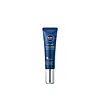What's inside
What's inside
 Key Ingredients
Key Ingredients

 Benefits
Benefits

 Concerns
Concerns

No concerns
 Ingredients Side-by-side
Ingredients Side-by-side

Water
Skin ConditioningGlycerin
HumectantMethylpropanediol
SolventBehenyl Alcohol
EmollientCaprylic/Capric Triglyceride
MaskingCetyl Alcohol
EmollientDistarch Phosphate
AbsorbentGlyceryl Stearate Citrate
EmollientStearyl Alcohol
EmollientDicaprylyl Ether
EmollientCocoglycerides
EmollientSodium Hyaluronate
HumectantTocopherol
AntioxidantXanthan Gum
EmulsifyingSodium Hydroxide
BufferingEthylhexylglycerin
Skin ConditioningCaprylyl Glycol
EmollientPhenoxyethanol
PreservativeWater, Glycerin, Methylpropanediol, Behenyl Alcohol, Caprylic/Capric Triglyceride, Cetyl Alcohol, Distarch Phosphate, Glyceryl Stearate Citrate, Stearyl Alcohol, Dicaprylyl Ether, Cocoglycerides, Sodium Hyaluronate, Tocopherol, Xanthan Gum, Sodium Hydroxide, Ethylhexylglycerin, Caprylyl Glycol, Phenoxyethanol
Water
Skin ConditioningButyrospermum Parkii Oil
EmollientCetearyl Alcohol
EmollientButylene Glycol
HumectantHydrogenated Polyisobutene
EmollientPhenyl Trimethicone
Skin ConditioningPolyglyceryl-3 Beeswax
EmulsifyingPolybutene
Sucrose
HumectantCetyl Esters
EmollientIsostearyl Neopentanoate
EmollientPolymethyl Methacrylate
Glycerin
HumectantCetearyl Glucoside
EmulsifyingTriticum Vulgare Germ Extract
Skin ConditioningHordeum Vulgare Extract
EmollientMethyl Glucose Sesquistearate
EmollientSigesbeckia Orientalis Extract
Skin ConditioningCamellia Sinensis Leaf Extract
AntimicrobialPolysilicone-11
Lactis Proteinum
Skin ConditioningCaffeine
Skin ConditioningGlyceryl Polymethacrylate
PEG-100 Stearate
Squalane
EmollientPEG-8
HumectantAcrylates/C10-30 Alkyl Acrylate Crosspolymer
Emulsion StabilisingPhytosphingosine
Skin ConditioningDimethicone
EmollientCholesterol
EmollientLinoleic Acid
CleansingSodium Hyaluronate
HumectantYeast Extract
Skin ConditioningDipropylene Glycol
HumectantPalmitoyl Hexapeptide-12
Skin ConditioningMagnesium Ascorbyl Phosphate
Antioxidant1,2-Hexanediol
Skin ConditioningCaprylyl Glycol
EmollientAminomethyl Propanol
BufferingTocopheryl Acetate
AntioxidantPotassium Sulfate
Stearic Acid
CleansingDisodium EDTA
Phenoxyethanol
PreservativeSodium Dehydroacetate
PreservativeMica
Cosmetic ColorantCI 77491
Cosmetic ColorantCI 19140
Cosmetic ColorantCI 77891
Cosmetic ColorantWater, Butyrospermum Parkii Oil, Cetearyl Alcohol, Butylene Glycol, Hydrogenated Polyisobutene, Phenyl Trimethicone, Polyglyceryl-3 Beeswax, Polybutene, Sucrose, Cetyl Esters, Isostearyl Neopentanoate, Polymethyl Methacrylate, Glycerin, Cetearyl Glucoside, Triticum Vulgare Germ Extract, Hordeum Vulgare Extract, Methyl Glucose Sesquistearate, Sigesbeckia Orientalis Extract, Camellia Sinensis Leaf Extract, Polysilicone-11, Lactis Proteinum, Caffeine, Glyceryl Polymethacrylate, PEG-100 Stearate, Squalane, PEG-8, Acrylates/C10-30 Alkyl Acrylate Crosspolymer, Phytosphingosine, Dimethicone, Cholesterol, Linoleic Acid, Sodium Hyaluronate, Yeast Extract, Dipropylene Glycol, Palmitoyl Hexapeptide-12, Magnesium Ascorbyl Phosphate, 1,2-Hexanediol, Caprylyl Glycol, Aminomethyl Propanol, Tocopheryl Acetate, Potassium Sulfate, Stearic Acid, Disodium EDTA, Phenoxyethanol, Sodium Dehydroacetate, Mica, CI 77491, CI 19140, CI 77891
Ingredients Explained
These ingredients are found in both products.
Ingredients higher up in an ingredient list are typically present in a larger amount.
Caprylyl Glycol is a humectant and emollient, meaning it attracts and preserves moisture.
It is a common ingredient in many products, especially those designed to hydrate skin. The primary benefits are retaining moisture, skin softening, and promoting a healthy skin barrier.
Though Caprylyl Glycol is an alcohol derived from fatty acids, it is not the kind that can dry out skin.
This ingredient is also used as a preservative to extend the life of products. It has slight antimicrobial properties.
Learn more about Caprylyl GlycolGlycerin is already naturally found in your skin. It helps moisturize and protect your skin.
A study from 2016 found glycerin to be more effective as a humectant than AHAs and hyaluronic acid.
As a humectant, it helps the skin stay hydrated by pulling moisture to your skin. The low molecular weight of glycerin allows it to pull moisture into the deeper layers of your skin.
Hydrated skin improves your skin barrier; Your skin barrier helps protect against irritants and bacteria.
Glycerin has also been found to have antimicrobial and antiviral properties. Due to these properties, glycerin is often used in wound and burn treatments.
In cosmetics, glycerin is usually derived from plants such as soybean or palm. However, it can also be sourced from animals, such as tallow or animal fat.
This ingredient is organic, colorless, odorless, and non-toxic.
Glycerin is the name for this ingredient in American English. British English uses Glycerol/Glycerine.
Learn more about GlycerinPhenoxyethanol is a preservative that has germicide, antimicrobial, and aromatic properties. Studies show that phenoxyethanol can prevent microbial growth. By itself, it has a scent that is similar to that of a rose.
It's often used in formulations along with Caprylyl Glycol to preserve the shelf life of products.
Sodium Hyaluronate is hyaluronic acid's salt form. It is commonly derived from the sodium salt of hyaluronic acid.
Like hyaluronic acid, it is great at holding water and acts as a humectant. This makes it a great skin hydrating ingredient.
Sodium Hyaluronate is naturally occurring in our bodies and is mostly found in eye fluid and joints.
These are some other common types of Hyaluronic Acid:
Learn more about Sodium HyaluronateWater. It's the most common cosmetic ingredient of all. You'll usually see it at the top of ingredient lists, meaning that it makes up the largest part of the product.
So why is it so popular? Water most often acts as a solvent - this means that it helps dissolve other ingredients into the formulation.
You'll also recognize water as that liquid we all need to stay alive. If you see this, drink a glass of water. Stay hydrated!
Learn more about Water